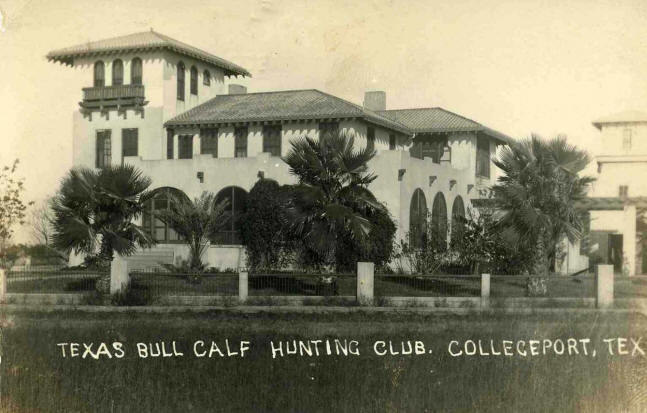|
|
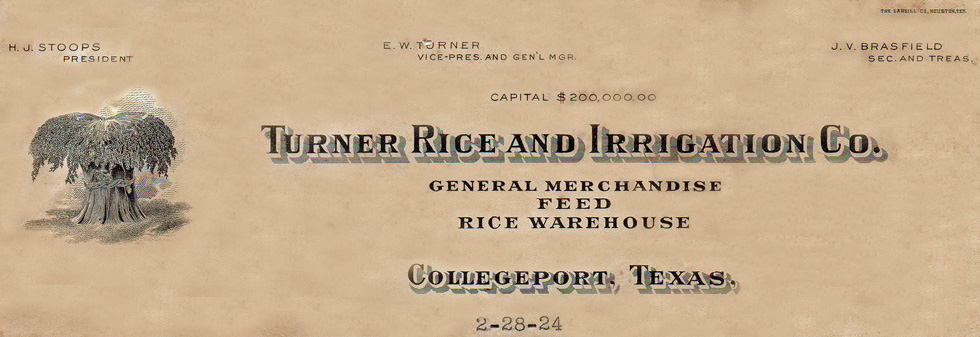 |
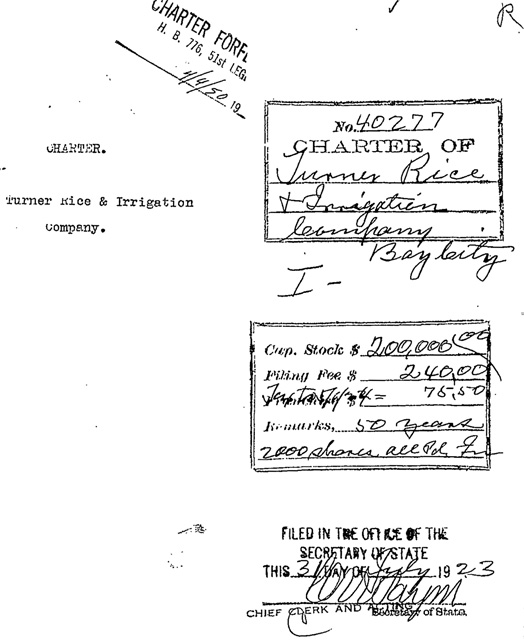 |
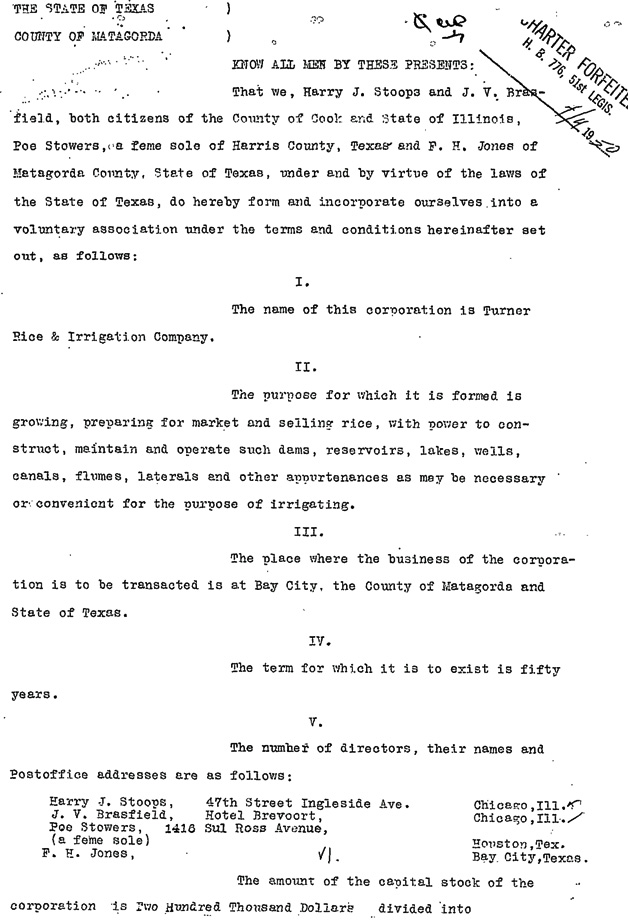 |
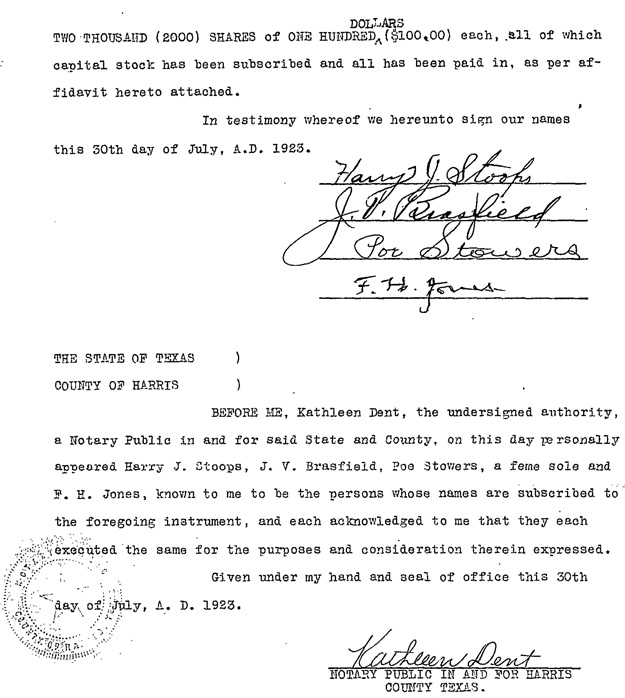 |
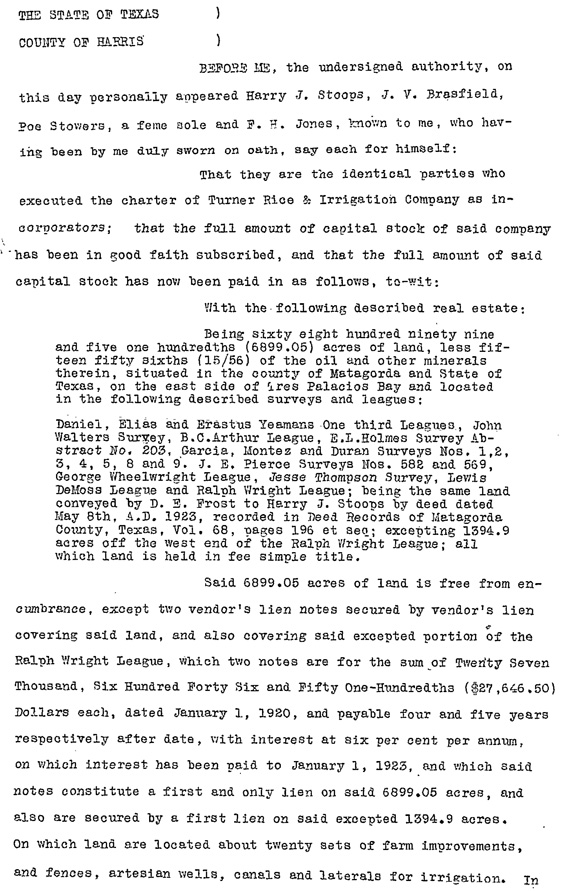 |
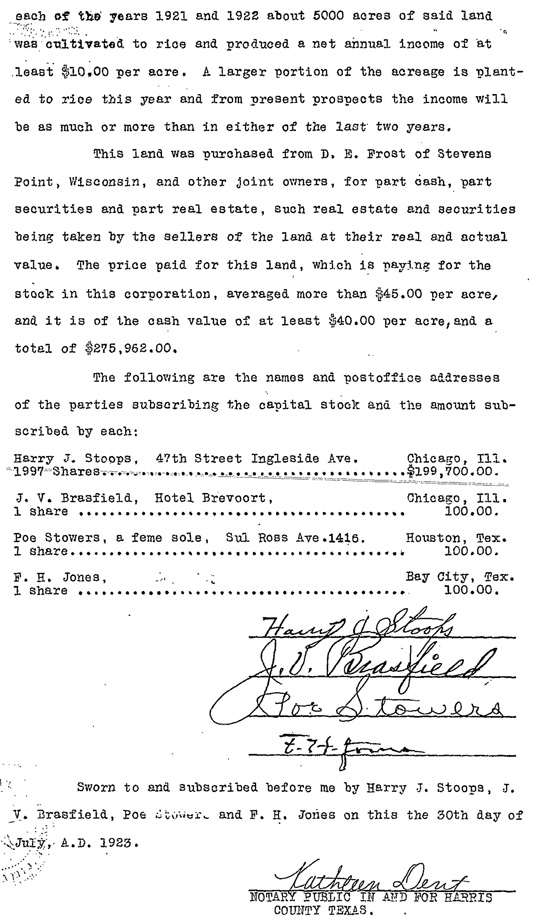 |
|
Turner Rice and Irrigation Company, Bay City; capital stock, $200,000. Incorporators: E. W. Turner, H. J. Stoops, Poe Stowers, F. H. Jones and others. The above is a news item sent out from the secretary of state office yesterday which concerns Bay City very much. E. W. Turner, one of the largest rice growers in the business and for whom the company is named, resides here. Judge F. H. Jones is, also, of this city. H. J. Stoops and Poe Powers are Chicago men.
The company will continue to operate in the
Collegeport section.--Matagorda County Tribune, August 3,
1923 |
|
One of the largest land deals ever made in South Texas and the only million dollar deal ever put over in Matagorda County has finally been settled and placed of record. Nearly $600,000 worth of revenue stamps were placed on the instruments of record. Along with the deal came the organization of a $200,000 corporation known as the E. W. Turner Rice & Irrigation Co., while the management of the development of the 20,000 aces will be left in the hands of Mr. Turner. The deal for the 20,000 acres also embraces the purchase of the canal system in that section, covering 45 miles of canals and laterals, all warehouses, improvements, store, stock and equipment used by the E. W. Turner rice plantation. The land consists of 8300 acres known as a portion of the J. E. Pierce Ranch, and 12, 000 acres known as the A. H. Wadsworth Portsmouth Ranch. The 8300 acres belonged to Wisconsin and Chicago interests; the Portsmouth Ranch to A. H. Wadsworth, of Bay City, Texas; the store and warehouse to E. W. Turner, of Bay City, Texas, and the canal and laterals to D. E. Frost, of Sevens Point, Wisconsin. The total consideration was over $1,000,000 and possibly, the first $1,000,000 deal of its kind ever made in the county. There have been many large ones, but this is, perhaps, the largest. The corporation that purchased the layout of lands, canals, store, warehouses and equipment is composed of Chicago capitalists. The officers are: Harry J. Stoops, president; J. V. Brasfield, treasurer; A. Miller, secretary; Orvice La Bounty, F. H. Jones (Bay City), A. Miller, Harry Stoops, J. V. Brasfield, directors. Judge F. H. Jones, of this city is attorney for the corporation. The intention of the company is general farming, rice being the principal crop and such lands as are most suitable will be developed into farms. Stock raising will also be given especial attention, all under the personal and direct management of E. W. Turner. The present plans call for the planting of 13,000 acres of rice next year, which will, possibly prove to be the largest rice plantation in the world under one management. This year's crop consists of 12,000 acres, which is said to be the best and earliest rice crop in the Southwest, and in which forty or more binders are at work cutting now. This crop is estimated, at the present time, at 150,000 bags which should bring about $600,000 with an average market. Mr. Turner is considered one of the most competent big rice farmers in the United States. The corporation plans to go in for pleasure and recreation as well as for business and is making its preparations to form one of the most unique hunting and fishing clubs in the Southwest. It is a settled fact, known to all hunters within a radius of 100 miles or more that Mad Island and Oyster Lake have no equal in the United States for fishing, oyster fishing or duck and geese hunting. Mad Island Lake consists of 188.5 acres and is 3 1/2 miles long. Oyster Lake consists of 3500 acres. To members of the hunting club to be formed will be given the right to hunt and fish upon the south 12,000 acres, or the Portsmouth Ranch, which embraces the lakes mentioned. The finest oyster beds in the Gulf abound on and adjacent to this property. The improvements planned will take in the large and beautiful home, known as the Theo. Smith home in Collegeport, which will be converted into a hunting lodge, while on the shores of Mad Island will be erected a modern club house to cost $25,000 and in which all modern conveniences will be installed.
The idea of all the amusement features is to make available, winter and summer, accommodations of the highest order, for tourists, members of the club or clubs and others seeking a delightful place for recreation. Returning to the business part of this ambitious as well as pretentious undertaking, it will not be amiss to state that E. W. Turner, who blazed the way and pioneered the rice industry in that section, has, within the three years he has farmed there on such tremendous scale, demonstrated that there is not a tract of land in the country better adapted to rice farming. It is said that this land has netted on an average for the three years over and above all expenses $20.00 an acre. There are many elements which have brought this successful farming venture to the present status and these are the sound water system of the Markham Irrigation Co., Mr. Turner' s executive ability and the plans of a gravity system of irrigation originated and put into service by A. J. Harty, of Bay City, after many engineers said it would not work.
So much for one huge undertaking that will
benefit the whole county and from this same source of information
comes the Chicago news that "Matagorda County is in for a boom."--Matagorda
County Tribune, August 10, 1923 |
|
|
|
|
Matagorda County Tribune, September 21, 1923 |
|
Cotton may be King in the South, Corn may be Queen in the North, but down here at Collegeport, rice is King, Queen, Jack and all the rest of the Royal family. The growing of rice at this place has been carried on in such a quiet manner that the world at large is ignorant that here is located the largest rice growing plantation in the world under one management. That is saying something, we know, but it is the truth. If the Japanese farmers over on that island could take one squint at the way rice is grown here, they would have another earthquake. Twenty-five thousand acres owned by one organization is some farm. Of this acreage 12,000 was used for rice this year and it produced 120,000 sacks of rough rice, which weighed about 28,000 pounds or say, 14,000 tons, or getting down to something tangible, 466 carloads. No wonder the Gulf Coast Lines run a "jerkwater" train once each way, daily except Sunday. Such traffic is not to be sneezed at. Thirty-five farmers operate that many farms or plats of rice and they employ an average of six hands each during the year, or 200 men, mostly Negroes, with a sprinkling of Mexicans. The 120,000 sacks sold for an average of $5.00 per sack, yielding the handsome sum of $600,000 for the crop, or about $50.00 per acre. Water is supplied through a Collegeport canal system of more than 40 miles, the water being brought through the gravity system of the Markham Irrigation gravity system which has more than 400 miles of canals and laterals. As the rough rice is brought from the machines it goes through the company warehouse which has a payroll of $10,000 per annum. All supplies are furnished from the company store which carries a stock of $25,000 and does a business of $120,000 per annum. The store, warehouse and office employ 12 men the year round. Five hundred mules, 24 tractors, 14 threshing machines and a world of plows, discs, drills and other machinery are required to handle the crop. At the present time ten cars of rice leave the warehouse each day, most of it being for export to Japan which is about the same as "carrying coals to Newcastle." This export rice is what is called Jap rice and this season, because of the earthquake in Japan has brought an unusual price and this has been made the average price per sack for all rice higher than in ordinary seasons. The company carries an average of $80,000 insurance on warehouse and $20,000 on store stock, or a total insurance of $100,000. Connected with the enterprise, but under separate management, is a large blacksmith shop and garage employing 10 men, an up to date meat market which requires one and one-half beeves each day and a modern drug store and soft drink fountain. The organization operating this great farming business is called the Turner Rice and Irrigation Company with a paid up capital of $200,000. Its officers are H. J. Stoops, president; E. W. Turner, vice president and general manager; J. V. Brasfield, treasurer, and A. L. Miller, secretary. All of these men live in Chicago except E. W. Turner who lives in the beautiful Burton D. Hurd home on the bay shore. Mr. Turner is the leading spirit of the organization. It was his brain which conceived the plan and brought it to its present magnitude and he is considered by all who know him as being one of the greatest men in the American rice game. He has great business capacity, wonderful executive ability and there is no detail of the business, no matter how small, that he is not acquainted with. Mr. Brasfield, an old timer in the development of Collegeport, brought rare promotion ability to the organization and introduced Mr. Stoops and his associates. Most people are under the impression that rice, being a water crop, is grown on low, marshy land, but the opposite is the case. Rice land must be high and easily and quickly drained. The lands must be flat and as level as possible so the water will stand at a uniform depth. The soil should be fairly deep, but underlaid with a clay subsoil which will hold the water and prevent it seeping into the ground. A shallow soil is desired because it dries out rapidly and harvesting is easier. All during the season the cry of the rice plants is for water and the rice farmer joins this cry for water, water for his thirsty plant requires eight gallons every minute, night and day per acre. This mean that during the growing season the Collegeport rice farm requires 96,000 gallons per minute or 5,760,000 gallons each hour. Some water! But the rice plant drinks it up, grows, thrives and yields a great human food. Water as a rule is raised from the rivers by enormous pumping plants and the distribution is by canals, but at Collegeport, all water is supplied through the greatest gravity water supply system in America if not in the world. When the rice crop has matured, water is cut off, levees opened and the ground dried off so that harvesting machines may enter the fields. These machines are exactly like those used for wheat harvesting except they are heavier and built with broader wheels. Rice straw is larger than wheat straw and heavier and the yield of grain per acre is greater and this requires heavier machines. The rice is shocked and stands in the field until taken to the thresher where it is threshed in same manner as wheat. From the machine it is delivered to the warehouse in bags which weigh from 180 to 200 pounds, depending on quality of the grain. At the warehouse it is graded, and sold to buyers who are employed by the mills or exporting firms. At the mills it is prepared for the consuming market. Although handled in the warehouse in bags which have an undetermined weight it is said by the barrel of 162 pounds or about four bushels. When cleaned or milled it is sold in "pockets" of 100 pounds. A barrel of rough rice will yield about 57 pounds fancy head rice, 27 pounds second grade, 15 pounds screenings, 33 pounds hulls, 25 pounds bran and polish and 5 pounds shrinkage. According to the last United States census report, Texas planted 164,471 acres of rice and the yield was 1,326,592 barrels. Of this acreage Matagorda County planted 37,927 acres and produced 246,590 barrels. The county acreage was increased this season and the yield in proportion. Comparing the county yield with the Collegeport production gives one a fair idea of the "ice cut in the rice" by Collegeport's great rice farm. Most of the grain is used for human and animal food, but a great economic waste results from the non use of the straw. Rice straw, because of its sweetness, is palatable and relished by cattle and Nelson of the Arkansas experiment station says that "properly cured rice straw is excellent for stock." In each 100 pounds of rice straw the total dry matter being 92.5 pounds, there are the following digestible nutrients: Protein, 9-10 pounds; carbohydrates, 37.8 pounds; fat, 3-10 pounds; total digestible nutrients, 39.1 pounds. Of all the straws, rye is the only one that has greater feed value than that of rice. Prairie hay has only 8.5 pounds more digestible nutrients than rice straw for the hauling pay $10.00 per ton for prairie hay. Same kind of economy is practiced by the farmer who burns oat strawstacks and pays $15.00 per ton for cotton seed hulls. As the farmers, ignorant of the feed value of rice straw, refuse to take it as a gift, the rice farmer, ignorant of its value as a fertilizing agent, burn the stacks each year. This season some farmers will buy commercial fertilizers to place on rice lands and experiments have already been made to determine which formula to buy, and yet each 100 pounds of rice straw contains the following: Nitrogen, 6.2 pounds; phosphoric acid, 1.4 pounds; potash, 15.4 pounds. Good farmers, farmers who study, farmers who own the land, would buy straw spreaders and haul this nitrogen, phosphoric acid and potash out on the land and thus save this valuable plant food. As they never do we must judge that they are not in the good farmer class. This is the curse of one crop farming, always taking away, never putting anything back. As this is being written the fields are dotted with great yellow straw stacks, their very color shrieking their value. No one has estimated the tonnage, but every ton contains 124 pounds nitrogen, 28 pounds phosphoric acid and 368 pounds potash. If one of these straw burners would go out into the market and buy this material, he would quickly realize the value of rice straw to the land which year after year is being robbed of the plant food which is necessary for a profitable crop. This waste is common all over rice districts. It ought to be used as feed, as fertilizer and there is enough to keep a big paper mill operating the year round. Yes, we are a wonderful people, but where in the world exist such grand wastrels as us Americans?
Matagorda County Tribune, November 30,
1923 |
|
All lands belonging to Pierce Pasture Co., known as the "Duncan Ranch" and especially the land farmed by E. W. Turner the past two years is lawfully posted. Trespassers will be prosecuted according to law. Signed by J. F. Hutchins, Executor and Gen.-Mgt. Pierce Estate
Matagorda County Tribune, December 2, 1927 |
